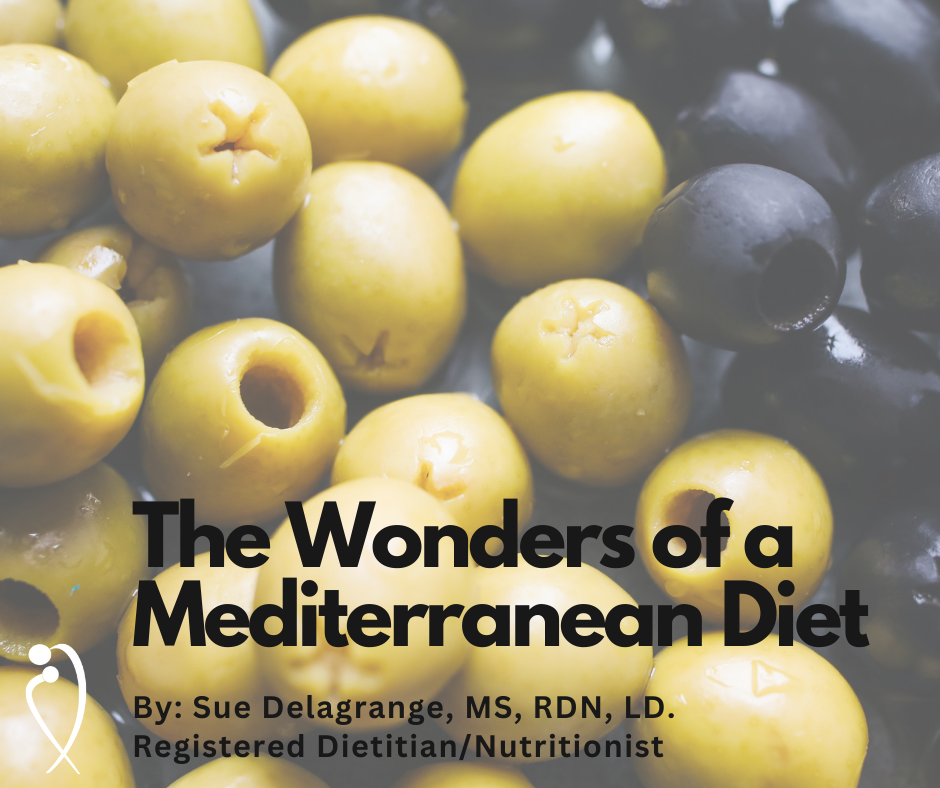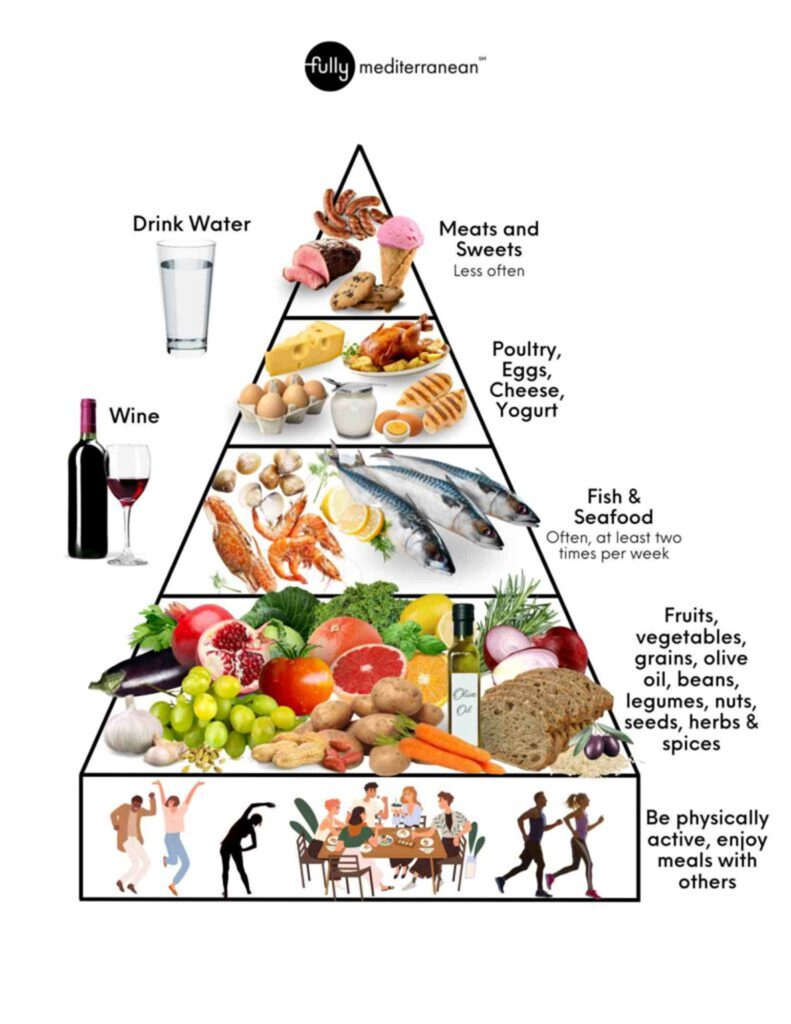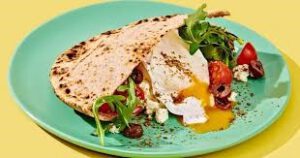
By Sue Delagrange, Registered Dietitian
The Path to Longer Life
The Mediterranean diet, also known as the Med Diet, is considered the gold standard when it comes to eating. It was named “Best Overall Diet” for 2019 by U.S. News and World Report. While the Med Diet is best known for its contribution to heart health, its benefits don’t end there. Countless studies have touted the many life-giving benefits of the Med Diet, demonstrating some level of protection from virtually all of the most serious and deadly chronic diseases.
Research-Backed Benefits
More than half a century ago, scientists studying cardiovascular disease noticed that residents of certain countries had a lower risk of developing and even dying from cardiovascular disease. One landmark study was the “The Seven Countries Study” that took place from 1958 to 1999. It examined how diet and other lifestyle factors were associated with coronary heart disease in seven countries: the U.S., Finland, the Netherlands, Italy, Greece, former Yugoslavia, and Japan. The study gave rise to what we now call the Mediterranean diet because it revealed that Greek and Italian dietary patterns were associated with reduced rates of coronary heart disease and all-cause mortality.
What they found was a link between individuals eating a traditional Mediterranean diet and a plethora of health benefits, including longevity, improved brain function, maintenance of a healthy weight, and a reduction of heart disease, diabetes, cancer, dental disease, and Alzheimer’s disease.
Rightfully named one of the world’s healthiest eating patterns, the Mediterranean diet places an emphasis on healthy fats from nuts, seeds, avocado and olive oil, along with vegetables, fruits, legumes, whole grains, herbs, and spices. It features fish and poultry, over red meat. Red wine is consumed regularly but in moderate amounts.
Mediterranean Diet Food Pyramid
Be physically active, and enjoy meals with others
Lifestyle is also a crucial factor in the Mediterranean-style eating plan—lifestyle factors such as physical activity and enjoying meals with others form the foundation of the Mediterranean food pyramid, since they are just as important as the food.
So, instead of gobbling your meal in front of the TV, slow down and sit at the table with your family and friends to savor what you are eating. Not only will you enjoy your company and your food, but eating slowly also allows you to tune in to your body’s hunger and fullness signals.
Fruits and Vegetables, Beans, Legume, Nuts, Seeds, Herbs and Spices
If you look at your diet and worry that there is barely a green to be seen, this is the perfect opportunity to fit in more veggies. An effective way to do this is to eat one serving at snack time, like crunching on bell pepper strips or throwing a handful of dark leafy greens into a smoothie, and one serving at dinner, such as steamed broccoli. A traditional Mediterranean diet promotes “eating the rainbow” via substantial amounts of fruits and vegetables, along with whole grains, beans, and legumes, as well as healthy fats from nuts, seeds, and olive oil. The resulting combo is potent in polyphenols, heart-healthy unsaturated fats, and fiber, which helps lower bad cholesterol, improve insulin sensitivity, and reduce chronic inflammation.
Whole Grains
Experiment with whole grains that are still in their “whole” form and have not been refined. Look for the “whole” or “whole grain” on packaging and in the ingredient list. It should be listed as the first ingredient. If you still find it too hard to make the switch from your old, refined favorites, phase in a whole grain by using whole-grain blends of pasta and rice or mixing a whole grain with a refined one (like half whole-wheat pasta and half white pasta).
Olive Oil
Olive oil is rich in monounsaturated fatty acids, which may improve HDL cholesterol, the “good” type. HDL cholesterol helps to remove “bad” LDL particles out of the arteries. Use olive oil in homemade salad dressings and vinaigrettes. Drizzle it on dishes like fish, chicken, or steamed veggies to boost the flavor and nutritional value.
Fish & Seafood
Fish is a welcome part of the Mediterranean diet. In particular, the diet emphasizes fatty fish including salmon, sardines, tuna, and mackerel, which are rich in heart and brain healthy omega-3 fatty acids. Fish that are leaner and have less fat, such as cod or tilapia, are still worth eating, as they provide a useful source of protein. Tinned fish is equally nutritious, in addition to being a budget friendly and sometimes more accessible option.
Meats, Poultry, and Dairy
One of the key components of the Mediterranean diet is how easy it is to follow. But, if you find yourself struggling to get by with less meat, do not feel like you need to give it up completely. Simply eating less can have positive health benefits, too.
Here are a few recipes you should try!
Feta, Egg, and Olive Pita
Recipe and photo from Eating Well | For a printable recipe, click here
Ingredients:
- 2 tablespoons plain Greek yogurt
- ½ whole-wheat pita
- ¼ cup baby arugula
- 2 tablespoons halved cherry tomatoes
- 1 large egg, poached
- 3 pitted Kalamata olives, chopped
- 1 tablespoon crumbled feta cheese
- ¼ teaspoon za’atar
Directions: Spread yogurt inside pita, Fill pita with arugula, tomatoes, poached egg, olives, and feta. Sprinkle with za’atar.
Nutrition Facts:
Serving size 1 sandwich. Calories: 287, Total Fat: 13g, Sodium: 610mg, Total carbohydrates: 27g, Fiber: 4g, Total sugar: 4g, Protein: 16g
One-Pot Beans & Rice with Corn & Salsa
Recipe and photo from Eating Well | For a printable recipe, click here
Ingredients:
- 1 tablespoon Olive oil
- 1 cup long-grain rice
- 1 medium onion, chopped
- 2 large cloves garlic, minced
- 1 tablespoon chili powder
- 2 teaspoons ground cumin
- ½ teaspoon salt
- ½ teaspoon ground pepper
- 1 (14 oz.) can petite-diced tomatoes
- 1 ½ cups water
- 1 (15 oz.) can no-salt-added black beans, rinsed
- 1 cup frozen corn
- ½ cup chopped cilantro
- 3 tablespoons salsa and/or shredded Mexican blend cheese
Directions:
- Heat oil in a large saucepan over medium heat. Add rice and cook, stirring, until starting to brown, about 3 minutes.
- Add onion, garlic, chili powder, cumin, salt, and pepper; cook, stirring, until fragrant: 1 to 2 minutes. Add tomatoes and water; bring to a boil, then reduce heat to maintain a simmer. Cover and cook until the liquid has been absorbed. 18-20 minutes.
- Remove from heat and fluff with a fork. Gently stir in beans and corn. Cover and let stand for 10 minutes. Stir in cilantro and serve with salsa and cheese, if desired.
Nutrition Facts:
Serves 4. Calories: 414, Total Fat: 9g, Sodium: 454mg, Total carbohydrates: 72g, Fiber: 12g, Total sugar: 6g, Protein: 12g
One-Pot Garlicky Shrimp & Broccoli
Recipe and photo from Eating Well | For a printable recipe, click here
Ingredients:
- 3 tablespoons extra-virgin olive oil, divided
- 6 medium cloves garlic, sliced, divided
- 4 cups small broccoli florets
- ½ cup diced red bell pepper
- ½ teaspoon salt, divided
- ½ teaspoon ground pepper, divided
- 1 pound peeled and deveined raw shrimp (21-30 count)
- 2 teaspoons lemon juice, plus more to taste.
Directions:
- Heat 2 tablespoons of oil in large pot over medium heat. Add half the garlic and cook until beginning to brown, about 1 minute. Add broccoli, bell pepper and ¼ teaspoon each salt and pepper. Cover and cook, stir once or twice, and add 1 tablespoon water if the pot is too dry, until the vegetables are tender, 3 to 5 minutes. Transfer to a bowl and keep warm.
- Increase heat to medium-high and add the remaining 1 tablespoon oil to the pot. Add the remaining garlic and cook until beginning to brown, about 1 minute. Add shrimp and the remaining ¼ teaspoon each salt and pepper; cook, stirring, until the shrimp are just cooked through, 3 to 5 minutes. Return the broccoli mixture to the pot along with lemon juice and stir to combine.
Nutrition Facts:
Serves 4. Calories: 214. Total Fat: 11g, Sodium: 441mg, Total carbohydrates: 6g, Fiber: 2g, Total sugar: 2g, Protein: 25g.








